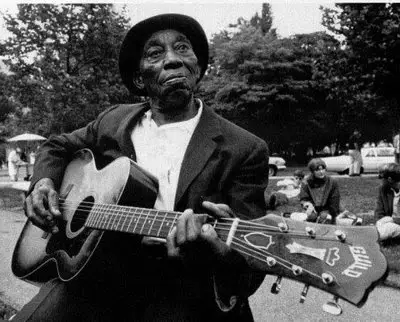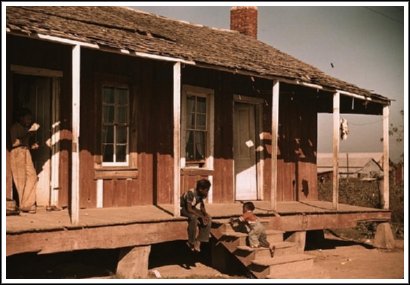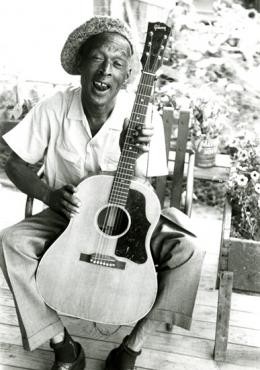Country Blues Guitar
 Country blues
can also be called acoustic blues, folk blues, backwoods blues, or
rural blues. Its a generic description that encompasses the acoustic,
mostly guitar-based style of blues music. It frequently included elements of gospel and ragtime guitar.
Country blues
can also be called acoustic blues, folk blues, backwoods blues, or
rural blues. Its a generic description that encompasses the acoustic,
mostly guitar-based style of blues music. It frequently included elements of gospel and ragtime guitar. The blues was created in the Southern States and rapidly spread to the rest of America which in turn caused the creation of many other regional styles, including include Chicago, Texas, Piedmont, Louisiana, West Coast, St. Louis, East Coast, New Orleans, Delta, and Kansas City blues.
When African-American audiences moved away from the blues in the early 1960s, preferring soul and rhythm and blues, so-called country blues became popular under the term "folk blues" and most of the sales were accounted for by mostly white audiences of college age.
Classic performers such as Sonny Boy Williamson and Big Bill Broonzy recreated themselves and became folk blues performers, and Piedmont blues players such as Brownie McGhee were big successes on the folk festival circuits, both in the US and in Europe. Some people think that country blues just means that country guitar music is mixed with the blues - this is not the case.
Delta Blues Guitar Music
 This is probably the first style of blues music
to have appeared. It came from the Mississippi Delta, an area noted
both for its fertile growing conditions and for the poverty of it's
inhabitants.
This is probably the first style of blues music
to have appeared. It came from the Mississippi Delta, an area noted
both for its fertile growing conditions and for the poverty of it's
inhabitants. The acoustic guitar is the dominant instruments utilized, and bottleneck guitar is characteristic of this style. The vocals could be sensitive and mournful, but also passionately emotional and fiery. Delta Blues is generally thought of as a variation of the broader category 'country blues'.
Even though Delta blues for sure existed by the beginning of the 20th century, it first recorded in the 1920s, when music publishing companies saw the possible profits in the colored audience for their Race records.
The big record labels produced the first records, which consisted more often than not of a person singing while playing the guitar.
DELTA BLUES GUITAR MUSIC
 This is probably the first style of blues music to have appeared. It came from the Mississippi Delta, an area noted both for its fertile growing conditions and for the poverty of it's inhabitants.
This is probably the first style of blues music to have appeared. It came from the Mississippi Delta, an area noted both for its fertile growing conditions and for the poverty of it's inhabitants. The acoustic guitar is the dominant instruments utilized, and bottleneck guitar is characteristic of this style. The vocals could be sensitive and mournful, but also passionately emotional and fiery. Delta Blues is generally thought of as a variation of the broader category 'country blues'.
Even though Delta blues for sure existed by the beginning of the 20th century, it first recorded in the 1920s, when music publishing companies saw the possible profits in the colored audience for their Race records.
The big record labels produced the first records, which consisted more often than not of a person singing while playing the guitar.
Medicine Show Guitar and String Bands
In live performances, it was more common to play with a band of guitarists. It is thought that Freddie Spruell was the first Delta blues man to cut a record. Freddie Spruell was born in 1893, probably in Lake Providence, which is in Louisiana. When he was a boy his family went to live in Chicago. He was one of the first guitar playing blues men to cut a record, with Okeh Records in 1926 - Milk Cow Blues on the A side and Muddy Waters Blues on the B side.While growing up in the Chicago area, his music developed a powerful Delta blues influence. He also called himself Papa Freddie Spruell, sometimes Mister Freddie and now and again Mississippi Freddie Spruell.
Freddie stopped playing the blues in the 1940's as his mother wanted him to go back into the church. Spruell was ordained as a preacher and he never played again, having died in Chicago in 1956. Talent scouts for the big record companies made some of the first recordings on trips to the South States, but sometimes the labels asked some Delta blues players to travel to Chicago and other cities to record.
Tommy Johnson and Ishman Bracey were recorded on the Victor label in 1928, Robert Wilkins was recorded by Victor in Memphis in 1928, and Big Joe Williams was recorded in Memphis in 1929 on the Brunswick label. Paramount recorded Son House in 1930 in Grafton, Wisconsin, and Charley Patton in 1929, 1930, and 1934 for the same company. Patton went to New York City for more recording sessions.
After that time, the early Delta blues and many other forms of American folk music were recorded by John Lomax and his son Alan Lomax, who traveled around the South systematically saving music performed by everyday people and aiding in helping categorizing American folk music. They recorded thousands of examples, which are archived in the Smithsonian Institution.
Piedmont Blues Guitar Exponents
 This came to be known as East Coast blues and generally refers to a guitar playing style which is a fingerpicking guitar approach in which an alternating thumb bass string structure with a regular pattern accompanies a syncopated melody which is created on the treble strings mostly picked with one or more fingers.
This came to be known as East Coast blues and generally refers to a guitar playing style which is a fingerpicking guitar approach in which an alternating thumb bass string structure with a regular pattern accompanies a syncopated melody which is created on the treble strings mostly picked with one or more fingers. The result is like ragtime piano, which probably gave the idea for this bouncy guitar style.
The phrase 'Piedmont Blues' was created by Peter B. Lowry, a blues music researcher. It is unlike other guitar styles, and in particular the Delta blues guitar style, by its syncopated bass rhythms.
The Ragtime Blues Guitar Masters
The Piedmont style probably began with the classic 'banjo frail' style of fingerpicking playing that was practice extensively in the South. It was based partially on banjo playing, guitar string bands, and ragtime piano techniques.A new generation of musicians modified these classic ragtime and syncopation techniques to play the blues in a very appealing way - many blues guitarists were influenced by players like Blind Blake and Gary Davis.
Author: Jim Bruce
Date: 2014-05-17
Category: Music
